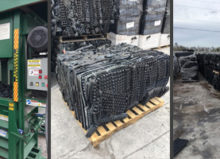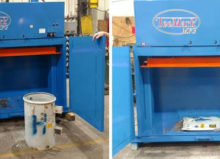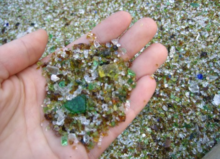What is a Glass Pulverizer?
 A Glass Pulverizer pulverizes beer, wine, liquor and soda glass bottles into sand and gravel with no sharp edges.
A Glass Pulverizer pulverizes beer, wine, liquor and soda glass bottles into sand and gravel with no sharp edges.
A Glass pulverizer converts standard beverage bottles into usable aggregate products that is safe and easy to handle. Pulverized glass can be used as an aggregate substitute for gravel and sand, as well as for glassphalt (e.g., glass/asphalt mixes for paving applications), turf and soil amendment, decorative landscaping and water filtration media. Pulverized glass can also be used on site for several applications, including road base, fill, and as a substitute for sand in other applications.
Our Glass Pulverizer models are geared towards glass recycling for size reduction and glass to sand aggregate for use in golf courses, public works projects, artwork, aquatics and concrete.
Frequently asked Questions
Who would benefit from a Glass Pulverizer?
- Recycling Centers
- Municipalities
- Bottlers
- Beverage Distributors
- Breweries
- Resorts
- Islands or Resorts that have a difficult time shipping out glass containers and beverage bottles.
What material can you pulverize?
- Beer, Wine, Soda, Liquor/Spirits Glass Bottles
- DRY, EMPTY standard glass containers, bottles, and small jars
What size glass does a glass pulverizer produce?
- The Internal trommel screen in our glass pulverizers separates glass into two usable sizes:
- 1/8 -inch minus
- 3/8 -inch minus
How much footprint does a Glass Pulverizer need?
- GP1000 Glass Pulverizer Dimensions: 80″ long x 76″ high x 29″ wide
- GP1000 Glass Pulverizer Dimensions: 166″ long x 78.5″ high x 29″ wide
How much does a Glass Pulverizer weigh?
- GP1000 Glass Pulverizer – 950 lbs.
- GP1000 Glass Pulverizer – 1600 lbs.
How does a Glass Pulverizer ship?
- LTL Truck on a skid or pallet or crate. LTL carriers are the most cost-effective choice.
How do you unload a Glass Pulverizer from the truck?
- A fork-lift is the most used machine for unloading the vertical baler from the shipping truck. The lifting equipment must be designed for lifting the weight of the pulverizer.
How do you install a Glass Pulverizer?
- This equipment should be installed on a level floor in a location that allows for the top feed design of the unit and allows for the removal of the crushed glass container. Included leveling feet can be used for leveling of unit. The area chosen for operation should allow for air flow.
- The unit should be wired to the proper voltage. Care should be given to ensure that the circuit can handle the crusher without overloading the circuit. Be sure that voltage supplied to the machine is the same voltage that is indicated on the nameplate. If there is a need for an outlet to plug the unit into, it is recommended that only a certified electrician do any additional wiring to ensure compliance. The user is responsible for conforming to the National Electrical Code and all other applicable local codes.
- All bearings are pre-lubricated at the factory. The motors are supplied with pre-lubricated bearings for the life of the motor. No further lubrication is required for the motor. However, the bearings for the crushing mechanism should be lubricated every six months under normal use.
Each conveyor is preassembled at the factory. However, there are a couple of items that require final assembly on site. Unpack the conveyor and place on a flat surface to complete assembly. Set aside all unattached parts that are packed inside the crate. Remove any wood blocks, strapping, tape, tags, and/or string from the conveyor. Check the conveyor carefully to make sure no damage occurred during shipment. Locate all unattached leg stands and mount them to frame using 3/8-24×1” bolts, 3/8” washers, and 3/8” lock nuts supplied. Conveyor should be lifted to the desired height and the legs positioned on the conveyor at the mounting bracket locations. The mounting holes are keyed for proper leg positioning. Two bolts are required for each leg. Take proper safety precautions to prevent damage to the equipment or personal injury. LEGS SHOULD ALWAYS BE AS PERPENDICULAR TO THE FLOOR AS POSSIBLE. After the legs are tightened securely and the conveyor is checked for stability, positioned the conveyor in your desired operation position.
How does a Glass Pulverizer work?
- These units are designed to crush standard glass bottles only. Do not place solid foreign articles, such as wood, iron, steel, or aluminum in the crusher as they WILL cause it to malfunction by causing a jam or a short and it WILL damage the crushing mechanism.
- Begin loading glass bottles into the feed opening. With some bottles feeding them with the neck down will allow them to enter the opening with less resistance. Continue feeding the bottles until the bins are full. After the glass bins are full empty them and repeat the process
Electrical Options for the Glass Pulverizer
- 220 Volts, Single Phase, 60Hz.
- 208, 230, or 460 Volts, 3 Phase, 60Hz.
Preventative Maintenance for the Glass Pulverizer
- Your glass pulverizer should not need cleaning under normal use. The trommel of the unit can be brushed off occasionally to clear the holes of any debris. The crushing mechanism can be cleaned by pouring small amounts of soap and water down the chute. NEVER PERFORM cleaning while unit it under power.
Compactors, Inc. Glass Pulverizers are used in many different venues.
- Municipalities where recycling glass bottles, and containers are important because their states are “no bottle deposit states”. The pulverized glass is used as aggregate, sold to end users, or given to users who have an application for pulverized glass (artist, manufactures, golf courses, concrete companies, and hardware stores).
- Resorts and private enterprises on remote Islands in the Caribbean where it is very costly to ship glass bottles and glass containers waste off island. Island customers use their pulverized glass as aggregate / fill in construction projects, concrete and architecture projects, sandbags, golf courses, and aquatics.
- Glass Recyclers and manufactures who receive or buy waste glass to pulverize and recycle into new glass containers, glass bottles, fiberglass, countertops, tiles, and art.



